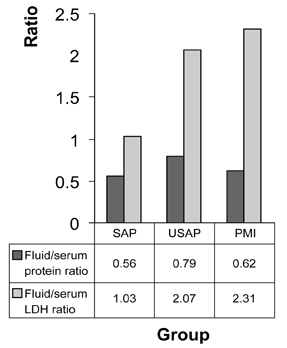Yonsei Med J.
2006 Jun;47(3):372-376. 10.3349/ymj.2006.47.3.372.
Analysis of C-Reactive Protein and Biochemical Parameters in Pericardial Fluid
- Affiliations
-
- 1Department of Cardiovascular Surgery, Trakya University Medical Faculty, Edirne. turanege@ttnet.net.tr
- 2Department of Anaesthesiology and Reanimation, Trakya University Medical Faculty, Edirne.
- 3Department of Cardiovascular Surgery, Gulhane Military Medical Academy Haydarpasa Training Hospital, Kadikoy, Istanbul, Turkey.
- KMID: 1715856
- DOI: http://doi.org/10.3349/ymj.2006.47.3.372
Abstract
- This study was designed to examine the relationship between pericardial fluid and plasma CRP levels, and to alterations in other biochemical parameters in patients undergoing Coronary Artery Bypass Grafting (CABG). The study group consisted of 96 Coronary Artery Disease (CAD) patients who were referred to our clinic for a CABG procedure and from whom sufficient amount of pericardial fluid could be collected. The patients were classified into 3 groups: Stable Angina Pectoris (SAP) (n=27), Unstable Angina Pectoris (USAP) (n=36), and Post-Myocardial Infarction (PMI) (n=33). Levels of CRP, glucose, albumin, total protein, Creatine Kinase (CK), Creatine Kinase-MB (CK-MB), and Lactate Dehydrogenase (LDH) were determined in pericardial fluid samples and in simultaneously collected blood samples from radial artery. The pericardial CRP and LDH levels in the PMI group were higher than in the SAP (p=0.015 and p=0.000, respectively) and USAP (p=0.011, p=0.047) groups. Serum CRP levels in USAP (p=0.014) and PMI (p= 0.000) groups were higher than those in the SAP group. Pericardial albumin levels in the PMI group were higher than in the USAP group (p=0.038). In all groups, the pericardial fluid/serum protein ratio was > 0.5, the LDL ratio was > 0.6, and pericardial fluid LDH concentrations were > 300mg/dl. CRP level of pericardial fluid was significantly higher in the PMI group than in other groups. However, pericardial fluid LDH levels were higher than blood LDH levels in this group and were also higher than pericardial fluid LDH levels of other groups.
Keyword
MeSH Terms
Figure
Reference
-
1. Spodick DH. Diagnostic interpretation of pericardial fluids. Chest. 1997. 111:1156–1157.2. Oyama J, Shimokawa H, Morita S, Yasui H, Takeshita A. Elevated interleukin-1β in pericardial fluid of patients with ischemic heart disease. Coron Artery Dis. 2001. 12:567–571.3. Strimel WJ, Noe S. Pericardial effusion. eMedicine Journal. 2002. 3.4. Corda S, Mebazaa A, Gandolfini MP, Fitting C, Marotte F, Peynet J, et al. Trophic effect of human pericardial fluid on adult cardiac myocytes. Differential role of fibroblast growth factor-2 and factors related to ventricular hypertrophy. Circ Res. 1997. 81:679–687.5. Meyers DG, Meyers RE, Prendergast TW. The usefulness of diagnostic tests on pericardial fluid. Chest. 1997. 111:1213–1221.6. Atar S, Chiu J, Forrester JS, Siegel RJ. Bloody pericardial effusion in patients with cardiac tamponade: is the cause cancerous, tuberculous, or iatrogenic in the 1990s? Chest. 1999. 116:1564–1569.7. Obaji A, Efferen LS. Diagnostic tests on pericardial fluid. Chest. 1998. 114:345.8. Lagrand WK, Visser CA, Hermens WT, Niessen HW, Verheugt FW, Wolbink GJ, et al. C-reactive protein as a cardiovascular risk factor: more than an epiphenomenon? Circulation. 1999. 100:96–102.9. Fransen EJ, Maessen JG, Elenbaas TW, van Aarnhem EE, van Dieijen-Visser MP. Enhanced preoperative C-reactive protein plasma levels as a risk factor for post-operative infections after cardiac surgery. Ann Thorac Surg. 1999. 67:134–138.10. Pasceri V, Willerson JT, Yeh ET. Direct proinflammatory effect of C-reactive protein on human endothelial cells. Circulation. 2000. 102:2165–2168.11. Fichtlscherer S, Rosenberger G, Walter DH, Breuer S, Dimmeler S, Zeiher AM. Elevated C-reactive protein levels and impaired endothelial vasoreactivity in patients with coronary artery disease. Circulation. 2000. 102:1000–1006.12. Burgess LJ, Reuter H, Taljaard JJ, Doubell AF. Role of biochemical tests in the diagnosis of large pericardial effusions. Chest. 2002. 121:495–499.13. Laurier E, Gosset D, Hennache B, Nuttens MC, Debuire B, Lenoir L, et al. Pericardial C-reactive protein. A marker of agonal cardiac disease? Presse Med. 1991. 20:405–408.14. Maulik N, Yoshida T, Das DK. Oxidative stress developed during the reperfusion of ischemic myocardium induces apoptosis. Free Radic Biol Med. 1998. 24:869–875.15. Park JL, Lucchesi BR. Mechanism of myocardial reperfusion injury. Ann Thorac Surg. 1999. 68:1905–1912.16. Piper HM, Garcia-Dorado D. Prime causes of rapid cardiomyocyte death during reperfusion. Ann Thorac Surg. 1999. 68:1913–1919.17. Heffner JE, Nietert PJ, Barbieri C. Pleural fluid pH as a predictor of pleurodesis failure: analysis of primary data. Chest. 2000. 117:87–95.18. Wu AH, Apple FS, Gibler WB, Jesse RL, Warshaw MM, Valdes R Jr. National Academy of Clinical Biochemistry Standards of Laboratory Practice: recommendations for the use of cardiac markers in coronary artery diseases. Clin Chem. 1999. 45:1104–1121.19. Couthon F, Clottes E, Vial C. High salt concentrations induce dissociation of dimeric rabbit muscle creatine kinase. Physico-chemical characterization of the monomeric species. Biochim Biophys Acta. 1997. 1339:277–288.
- Full Text Links
- Actions
-
Cited
- CITED
-
- Close
- Share
- Similar articles
-
- Biochemical Analysis of Serum and Pericardial Fluid in Patients with Hemorrhagic Pericardial Effusion
- The Usefulness of Pericardial Biopsy to Evaluate the Causes of Pericardial Disease
- Bacteria as Normal Flora in Postmortem Body Fluid Samples
- Pericardial tamponade caused by massive fluid resuscitation in a patient with pericardial effusion and end-stage renal disease: A case report
- A "Vanishing", Tuberculous, Pericardial Effusion


